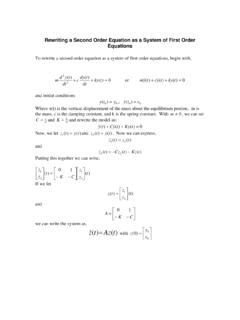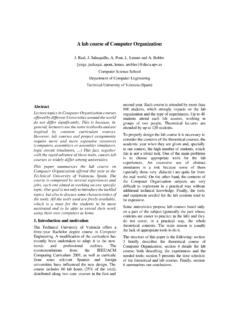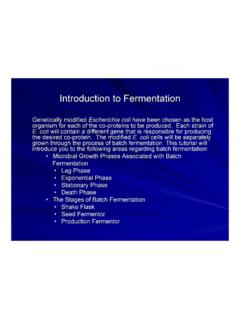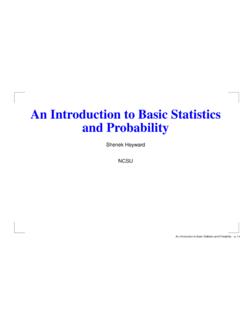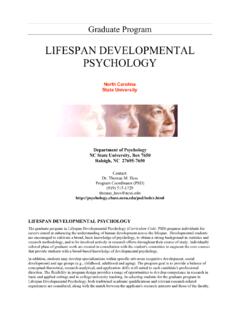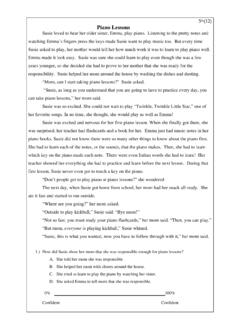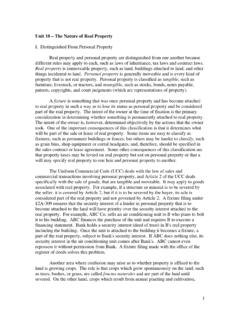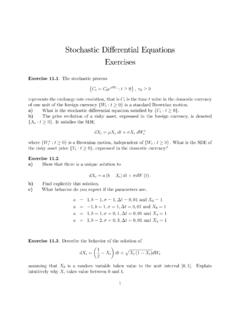Transcription of Parameter Estimation for Random Di erential Equation Models
1 Parameter Estimation for Random Differential Equation Banks and Michele L. JoynerCenter for Research in Scientific ComputationNorth Carolina State UniversityRaleigh, NC, United StatesandDept of Mathematics and StatisticsEast Tennessee State UniversityJohnson City, TN 37614 December 13, 2016 AbstractWe consider two distinct techniques for estimating Random parameters in Random differential Equation (RDE) Models . In one approach, the solution to a RDE is represented by a collection of solution trajectories inthe form of sample deterministic equations . In a second approach we employ pointwise equivalent stochasticdifferential Equation (SDE) representations for certain RDEs. Each of the approaches is tested using deter-ministic model comparison techniques for a logistic growth model which is viewed as a special case of a moregeneral Bernoulli growth model. We demonstrate efficacy of the preferred method with experimental datausing algae growth model words: Parameter Estimation , Random differential equations , stochastic differential Equation equiv-alents, model comparison techniquesMathematics Subject Classification: 34K29, 34K50, 65L09, 37H10, 49N4511 IntroductionIn this paper, we examine techniques for estimating Random variable parameters in Random differentialequation (RDE) Models .
2 Our ultimate research effort lies in the development of model comparison techniquesfor RDE Models which are presented in a separate article [5]. However, in that effort, it is necessary toestimate optimal parameters for use in the test statistic. Overall, the theory [4, 12] for RDE is muchless advanced than that for stochastic differential equations (SDE). While the questions of existence anduniqueness of solutions are without question important, for this presentation we simply assume that the RDEwe investigate have a unique solution, and focus on discussion of the Equation for the probability densityfunction of the solution. Due in part to their wide applicability [7, 11, 13], RDE have enjoyed considerableresearch efforts on computational methods in the past decade. Widely used approaches include MonteCarlo methods, stochastic Galerkin methods and probabilistic collocation methods (also called stochasticcollocation methods) [9, 8, 14].
3 Specifically, both Monte Carlo methods and probabilistic collocation methodsseek to solve deterministic realizations of the given RDE (and thus both methods were developed in thespirit of the sample function approach). The difference between these two methods rests primarily in themanner in which one chooses the sampling points. Monte Carlo methods are based on large sampling ofthe distribution of Random input variables while probabilistic collocation methods are based on quadraturerules (or sparse quadrature rules in high-dimensional space). stochastic Galerkin methods are based on(generalized) polynomial chaos expansions, which express the unknown stochastic process by a convergentseries of (global) orthogonal polynomials in terms of Random input parameters. Interested readers can referto [14] and the references therein for difficulties which have arisen in dealing with RDE may be due in part to the inability to accuratelyestimate parameters in the Models .
4 Here we compare two different techniques for estimating these randomvariable parameters and determining the accuracy of each method. Since the model selection criteria wehave developed [5] extends the techniques for deterministic systems, we only consider Parameter estimationtechniques which are also extensions of methods developed for Estimation of parameters in A Brief Overview of Random Differential EquationsA general Random ordinary differential Equation (RDE) containing Random Parameter values can be writtenasdxdt=g(t,x,Q),x(0) =x0(1)whereQis am-dimensional Random vector. For example, consider the logistic deterministic model given bydxdt=rx(t)(1 x(t) )(2)whereris the growth rate and is the limiting capacity. In this deterministic model, bothrand areassumed to be constant Parameter values. One may formulate a logistic RDE model by instead assumingthat one or both of these Parameter values are Random variables which behave according to some known(or to be determined) distribution.
5 For example, ifR N( R, 2R) is a Random variable Parameter for thegrowth rate and one assumes the limiting capacity is a constant, thendx(t;Q)dt=Rx(t;Q)(1 x(t;Q) )(3)is a RDE with Random variable parameterQ=R. If instead we letR N( R, 2R) andK N( K, 2K),thendx(t;Q)dt=Rx(t;Q)(1 x(t;Q)K)(4)2is a RDE with Random variable parameterQ= [R,K].Regardless of the type of mathematical model, Parameter Estimation is a vital step in the development ofthe model. The validation of a mathematical model with empirical data allows one to use the model to gaininsights into the processes inherent in the system as well as investigate the potential effect of perturbationson or within the system. If we re-examine each of the above Models , we note that the Parameter estimationproblem is slightly different for each of them. In the deterministic model (Eq. (2)), bothrand areconstants; therefore, it is necessary to estimate only two parameters in this model.
6 In Equation (3) in which is constant and the growth rate is now assumed to be a Random variable,R N( R, 2R), there areeffectively three values which must be estimated to fully determine the RDE model: , R, and R. IfRwas assumed to satisfy a different statistical distribution, then it would be necessary to estimate all theparameters to determine completely the assumed distribution. In the last model in Equation (4), both thegrowth rate,R, and limiting capacity,K, are assumed to be Random variable parameters behaving accordingto a normal distribution. Hence, in this model, we must be able to estimate R, R, K, and K. Therefore,the Parameter Estimation problem is different depending on which variables are assumed to be randomvariables and the choice of any assumed distribution for each Random variable Parameter . In Section 3, weconsider the solution to the RDE to be a collection of solution trajectories to a sample deterministic such, we develop a method for Parameter Estimation which utilizes the sample deterministic systemand methods for Parameter Estimation in deterministic systems.
7 In Section 4, we also utilize deterministicmethods for Parameter Estimation ; however, the method developed in this section is based on the equivalenceof an RDE model to a stochastic differential Equation (SDE) model and the relationship between a SDEmodel and deterministic system for large population Method 1: Parameter Estimation Method Using Sample Deter-ministic EquationThere are two common ways to approach RDE, the mean calculus approach and the sample function approach[2]. We use here the sample function approach in which one considersindividual realizationsof the realization of the RDE is a solution to a deterministic differential Equation , called a sample deterministicdifferential Equation , which is assumed here to have a unique solution [2]. For example, for every realizationrofR N( R, 2R) in the RDE model, we obtain the deterministic differential Equation given by Equation (2). In this approach to RDE Models , the solution to an RDE is a collection of solution trajectories tothe sample deterministic equations .
8 Leth(t;Q) represent the observation process in the RDE model andfd(t,q) be the observation process in the sample deterministic differential Equation . Then we can assumedataz= (z1,z2,..zN)Tis a realization of a Random variableZwhich is generated from a stochastic processgiven by a true RDE model and can be defined asZj=h(tj;Q0) +Ej=fd(tj;q0) +Ej, j= 1,..,N(5)whereEjis a normally distributed Random variable with meanE(Ej) = 0 and known varianceV ar(Ej) = 20,Q0is the true Random variable Parameter in the RDE system, andq0is a realization of the Random , to obtain a Parameter estimate, we first defineJNRDE1(q;Z) =1NN k=1(Zk fd(tk;q))2(6)to be the cost function. We then seek an estimatorqNRDE1= arg minq qJNRDE1(q;Z)with realization qNRDE1= arg minq qJNRDE1(q;z).(7)3 This estimator could be approximated by an estimate for the realizationqofQgiven a specific data setz. However, as discussed above, we need to estimate all statistical parameters which completely defineQ,not simply one realization ofQ.
9 Given multiple data setszkfor the given physical system, we can estimatethe statistical parameters for the distribution. For example, in Equation (3), we need to estimate both themean Rand the standard deviation R. If we haveMdata sets for the physical system, then we can obtainestimates qk,k= 1,..,Musing Equation (7) for each data setzk,k= 1,..,M. For an arbitrary randomvariable parameterQi N( i, i), then the mean ican be approximated by i 1MM k=1( qi)k.(8)Similarly, the standard deviation can be approximated by i 1MM k=1(( qi)k i).(9)We note that given only one data set,M= 1, Equation (8) yields i ( qi)1; substituting iinto Equation (9), we have i= 0. Therefore, it is necessaryto have multiple data sets in order to approximate thestandard deviation using this method. If one assumes the Random variable parameters behave according toa distribution different from the normal distribution or the distribution is unknown, one can use tools in acomputational software such as Matlab or Minitab to estimate the statistical distribution parameters and/orto determine the distribution which best fits the set of estimates{( qi)k}Mk=1for each Method 2: Parameter Estimation Method Using a PointwiseEquivalent SDE ModelAn alternate method is based on the pointwise equivalence between a RDE and a SDE model.
10 Establishedin [4] and summarized in [2], it was shown that there are classes of RDEs which are pointwise equivalentto corresponding It o SDEs. If one assumes the solution to a RDE is a stochastic sample solution, ,the collection of solution trajectories of the sample deterministic equations , then there are classes of RDEsfor which their solutions have the same probability density function at each timetas the solutions tocorresponding It o SDEs. Two such classes are given in [2, 4].The first class are RDEs of the formdx(t;X0,Q)dt= (t)x(t;X0,Q) + (t) +Q %(t), x(0;X0,Q) =X0,(10)whereQ= (Q0,Q1,.. Qm 1)T,Qj N( j, 2j),j= 0,1,2,.., m 1 and%= (%0, %1,.., %m 1)T, and are non- Random functions oft. It is shown in [2] that a Random differential Equation of this form ispointwise equivalent to the SDE given bydX(t) = ( (t)X(t) + (t) + %(t))dt+ 2h(t)dW(t), X(0) =X0,(11)if%has the property that the functionh(t) =m 1 j=0 2j%j(t)( t0%j(s)exp( ts ( )d )ds)is non-negative for anyt 0.
